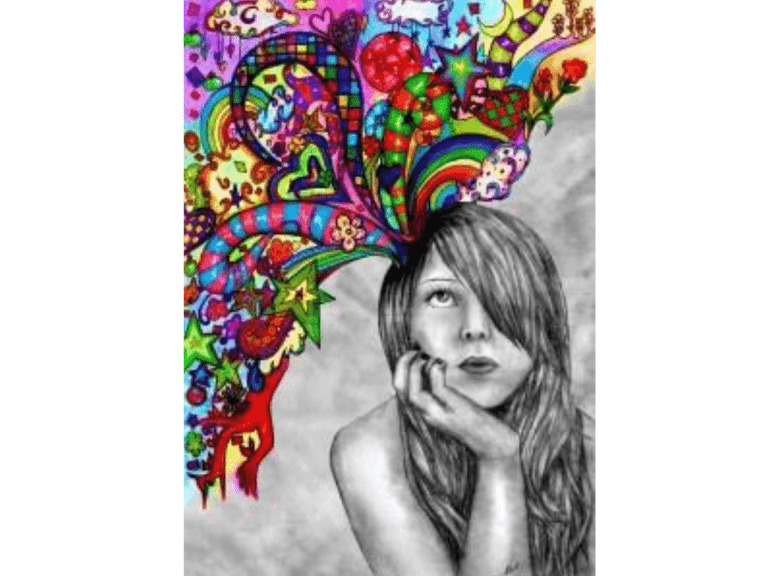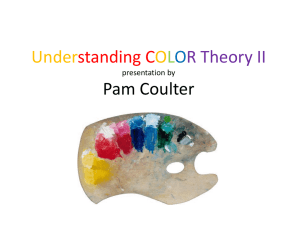Color Theory Power Point
advertisement

Color Theory • The color wheel fits together like a puzzle each color in a specific place. • Being familiar with the color wheel not only helps you mix colors when painting, but in adding color to all your art creations. • In 1672 Sir Isaac Newton 1st represented the relationship of colors to one another in the form of a circle after he observed a beam of sunlight passing through a prism, producing a rainbow Color Can Evoke Emotion • One hundred years later, Johann Wolfgang van Goethe, a German writer and scientist, studied how colors make us feel – He discovered that blue evoked quiet moods and that red evoked cheerfulness Bay Side, Helen Frankenthaler, 1967 The Golden Wall, Hans Hofmann, 1961 Haystack At Giverny, Claude Monet, 1891 The Scream, Edvard Munch, 1893 Still Life, Tulips, Emil Nolde, 1930 Voodoo, Judy Pfaff, 1981 The Old Guitarist, Pablo Picasso, 1903 Blue, Orange, Red, Mark Rothko, 1961 Starry Night, Vincent van Gogh, 1889 Self Portrait, Vincent van Gogh Sunflowers, Vincent van Gogh, 1888 The Magic Flute, Marc Chagall, 1966 Blumenstilleben St. Jean Cap Ferrat, Marc Chagall, 1956 At the Moulin Rouge, Toulouse-Lautrec, 1892 Goldfish, Henri Matisse, 1912 Woman with a Hat, Henri Matisse, 1905 A Glimpse of Notre-Dame in the Late Afternoon, Henri Matisse, 1902 Cirebon Sawah, Gwen Shackleton, 2007 Where do we come from? What are we? Where are we going?, Paul Gauguin, 1897 Primary Colors Colors from which all other colors are made • Red • Yellow • Blue Secondary Colors Colors that are created from mixing equal amounts of a pair of primary colors • Orange • Green • Violet Intermediate Colors Colors made from equal amounts of a pair of primary and secondary colors • • • • • • Yellow-Green Yellow-Orange Blue-Green Blue-Violet Red-Violet Red-Orange Neutral Colors The principles of color mixing let us describe a variety of colors, but there are still many colors to explore. The neutral colors contain equal parts of each of the three primary colors. Black, white, gray and sometimes brown are considered "neutral”. Tints Tints are lightened colors. Always begin with white and add a bit of color to the white until the desired tint is obtained. This is an example of a value scale for the tints of blue. Shades Shades are darkened colors. Always begin with the color and add just a bit of black at a time to get the desired shade of a color. This is an example of a value scale for the shades of blue. Color Schemes are a systematic way of using the color wheel to put colors together… in your art work, putting together the clothes you wear, deciding what colors to paint your room….. monochromatic, complementary, analogous, warm and cool. Monochromatic “Mono” means “one”, “chroma” means “color”… monochromatic color schemes have only one color and its values. The following slide shows a painting done in a monochromatic color scheme. This non-objective painting has a monochromatic color scheme blue and the values (tints and shades) of blue. Complementary Complementary colors are opposite on the color wheel provided a high contrast - if you want to be noticed wear complementary colors! This painting has complementary colors and their values - blues and oranges. Analogous The analogous color scheme is 3-5 colors adjacent to each other on the color wheel. This combination of colors provides very little contrast. Analogous colors are illustrated here: yellow, yellowgreen, green and blue-green. Warm The colors found in fire and the sun. Warm colors make objects look closer in a painting or drawing. This is an illustration of the use of warm colors - reds, oranges and yellows. Cool The colors found in snow and ice and tend to recede in a composition. Note the cool color scheme in this painting (greens, purples and blues). Complementary Colors • Colors opposite each other on the color wheel • Ex: • Red & green • Blue & orange • Yellow & violet Analogous Colors Three consecutive colors on the color wheel • Who is wearing a monochromatic shirt today? • Are wearing mainly warm colors? • Aare wearing mainly cool colors? • Is anyone wearing a shirt that uses complementary colors or analogous colors? • Can you think of an example of complementary colors being used together? • Tint: a color plus white • Shade: a color plus black • Monochromatic: one color in different tints and shades • Neutral: white, black, gray Complex Color Wheels • Create a complex design that follows the basic format of a color wheel while showing the Primary, Secondary, and Intermediate colors and the various tones and shades of each • You can take this assignment one step further by demonstrating your knowledge of complementary colors also







